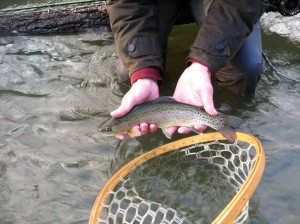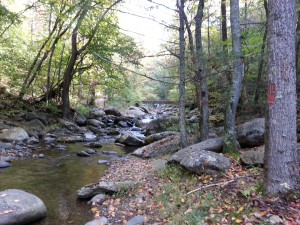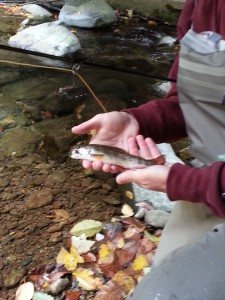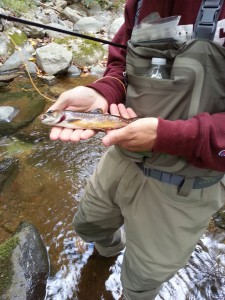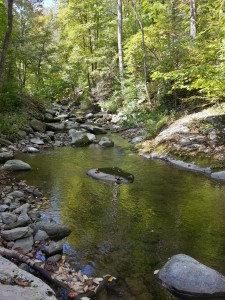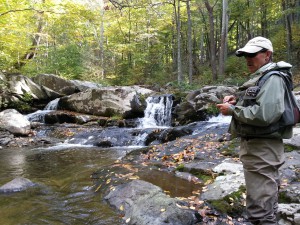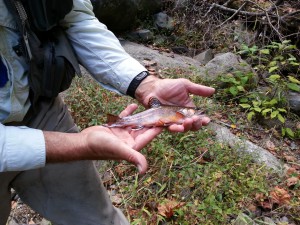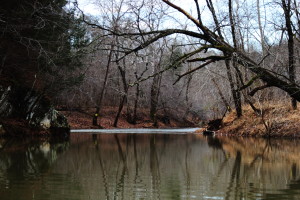
The scenic Moormans River on Sugar Hollow Farm
This past weekend, I had the opportunity to get out on the water with Cole from Albemarle Angler to target some rainbow trout. We fished a private stretch of the Moormans River that’s on Sugar Hollow Farm just outside of Charlottesville, Virginia. Albemarle Angler has access rights to about 3/4 of a mile of this river, and they stock it each year with a hefty number of trout. Unfortunately, there’s really no wild or holdover fish in this river since it’s a tailwater fed with water from the top of a dam, and it just gets too warm during the summer to support the trout. This does make for a hefty smallmouth population, though!
My trout experience is pretty limited in rivers. Growing up on Cape Cod, the only trout you really caught were in lakes, with the extraordinarily rare catch of a sea-run brown trout. Since I focus so much of my time on warmwater or saltwater species, I haven’t had tons of time to learn proper ways to read a river or practice delivering a fly to a trout. I usually only get out for trout once or twice per year, and never in the winter. I was very excited to start picking up new techniques to add to my arsenal.
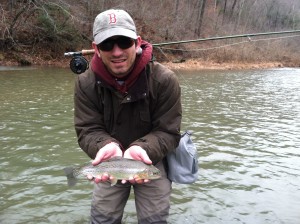 We suited up and got in the river. It was pretty stained from the previous day’s rain, but wasn’t too muddy. Cole tied on a Kreelex for me, and told me how to fish the first hole. A few casts in, I get my first strike. After a hard fight and some acrobatic jumps, we have about a 14″ rainbow in the net. A few casts later, I was hooked up again with another beautiful, hard fighting rainbow trout.
We suited up and got in the river. It was pretty stained from the previous day’s rain, but wasn’t too muddy. Cole tied on a Kreelex for me, and told me how to fish the first hole. A few casts in, I get my first strike. After a hard fight and some acrobatic jumps, we have about a 14″ rainbow in the net. A few casts later, I was hooked up again with another beautiful, hard fighting rainbow trout.
The trout Albemarle Angler put in the river aren’t your standard stocked trout. They feed on natural river-based food, rather than hatchery food. The fish still readily take a fly, but their natural diet makes them a bit more wily, and much closer to a wild trout than your typical stocker.
I was impressed with how well Cole knew the waters. Despite the stained water, he could tell me exactly where every feature of the river was. He knew where the ledges were, where I could walk out on a sandbar, and where to avoid so I didn’t snag. All I could see was muddy water. This knowledge paid off, though, and he kept me on fish all day. He knew when to switch up the fly, and just how to present it to maximize your chances at a strike.
Ready to book with Albemarle Angler? Be sure to leave a review if you try them out! They can be reached at albemarleangler@gmail.com via email or by phone at (434) 977-6882. Rates for a full day floats are $350 including lunch, and wading trips start at $225 for a half day. Albemarle Angler targets smallmouth bass from mid-March through mid-October, and trout (brook, brown, rainbow, and tiger trout!) from mid-September to mid-June depending on water flows. They fish the Shenandoah and James Rivers for smallmouths, and various rivers, streams, and creeks (including some private water) for trout. Albemarle Angler is also a full service fly shop located at 1129 Emmet St, Charlottesville, Virginia, 22903. As if all that isn’t enough, they also coordinate fly fishing trips across the globe.
